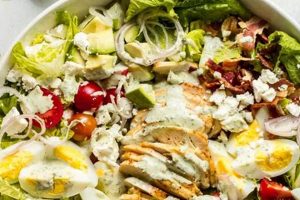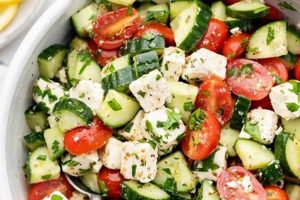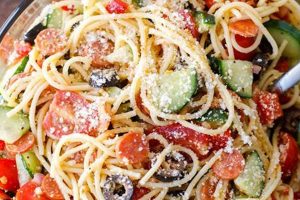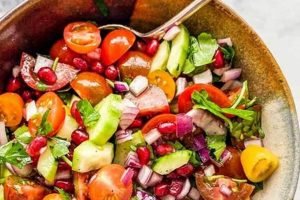A simple preparation of this dish typically involves a base of crisp tortilla chips layered with seasoned ground meat (often beef or turkey), a variety of fresh vegetables such as lettuce, tomatoes, onions, and cheese, and finished with a creamy dressing, frequently a sour cream or avocado-based sauce. Variations can include beans, corn, olives, salsa, or other preferred toppings, offering a customizable and convenient meal.
Quick and adaptable, this meal offers a convenient way to enjoy the flavors of tacos without the limitations of traditional shells. Its versatility allows for customization based on dietary preferences and ingredient availability, making it a practical choice for families and individuals. The combination of crunchy chips, flavorful meat, and fresh vegetables provides a texturally and nutritionally satisfying dish. Its popularity has risen over time due to its ease of preparation and adaptability to potlucks and casual gatherings.
The following sections will explore variations on this popular dish, including vegetarian options, tips for achieving optimal crispiness, and suggestions for creative dressings and toppings. Nutritional information and guidelines for making ahead and storing leftovers will also be provided.
Tips for a Successful Taco Salad
Achieving a truly satisfying taco salad involves attention to a few key details. These tips will help ensure a flavorful and texturally pleasing experience.
Tip 1: Chip Selection is Crucial: Opt for sturdy, restaurant-style tortilla chips. Thinner chips tend to become soggy quickly. Consider baking homemade tortilla chips for enhanced flavor and control over ingredients.
Tip 2: Seasoning Makes a Difference: Pre-made taco seasoning offers convenience, but blending individual spices allows for customized flavor profiles. Experiment with chili powder, cumin, paprika, and oregano.
Tip 3: Temperature Matters: Serve the components at optimal temperatures. Room-temperature ingredients like lettuce and tomatoes pair well with warm, freshly cooked meat. Cheese can be added warm or cold based on preference.
Tip 4: Layering Prevents Sogginess: Strategic layering keeps the chips crisp. Start with a layer of chips, followed by a thin layer of meat and cheese. Add a layer of heartier vegetables like onions and beans, then lighter, more delicate ingredients like lettuce and tomatoes. Top with dressing just before serving.
Tip 5: Dressing Choices Enhance Flavor: Traditional creamy dressings are popular, but consider lighter alternatives like a vinaigrette or a simple salsa. Avocado-based dressings add creaminess and healthy fats.
Tip 6: Freshness is Key: Using fresh ingredients elevates the overall flavor and texture. Prioritize ripe tomatoes, crisp lettuce, and freshly chopped onions.
Tip 7: Customize to Preference: The beauty of this dish lies in its adaptability. Explore different protein options beyond ground meat, such as shredded chicken or fish. Incorporate favorite vegetables and toppings to personalize the experience.
By following these tips, one can create a taco salad that is both delicious and satisfying. Attention to detail in each step contributes to the overall enjoyment of the dish.
The following section provides variations on this classic dish, offering inspiration for customization and exploration of diverse flavors.
1. Crisp Tortilla Chips
Crisp tortilla chips are fundamental to a successful taco salad. They provide a textural contrast to the other ingredients and serve as a vehicle for the flavors of the meat, vegetables, cheese, and dressing. Without sufficiently crisp chips, the salad can become soggy and unappetizing. The structural integrity of the chips is essential for maintaining the desired textural complexity. Consider a scenario where stale or soft tortilla chips are used: the salad quickly devolves into a mushy, unappealing mixture. This illustrates the direct impact chip crispness has on overall enjoyment. The choice of chip also affects flavor. Heavily salted chips can overpower other ingredients, while bland chips may fail to complement the robust flavors of the salad. Selecting a chip with a balanced flavor profile enhances the overall taste experience.
Several factors influence chip crispness. Freshness is paramount. Stale chips lose their crunch and become brittle. Proper storage in an airtight container helps maintain freshness. The type of oil used in frying also plays a role. Chips fried in oils with higher smoke points tend to be crispier. Homemade baked tortilla chips offer greater control over ingredients and freshness. Baking time and temperature also influence texture, offering opportunities for customization. Finally, the thickness of the chips contributes to their ability to hold their shape and texture when combined with other ingredients. Thicker chips generally offer greater structural integrity, while thinner chips offer a more delicate crunch.
Maintaining chip crispness presents a challenge when preparing taco salad in advance. The moisture from other ingredients can compromise the chips’ texture. Several strategies can mitigate this issue. One approach is to layer the ingredients strategically, placing the chips at the bottom and adding the wetter ingredients like tomatoes and dressing just before serving. Another technique involves serving the components separately, allowing individuals to assemble their salads and maintain chip crispness. Understanding the factors that contribute to chip crispness and employing appropriate techniques ensures a satisfying and texturally balanced taco salad.
2. Seasoned Ground Meat
Seasoned ground meat forms the foundational savory element in many taco salad iterations. Its presence significantly influences the overall flavor profile and satisfaction derived from the dish. The choice of meat, typically beef or turkey, and the specific seasoning blend contribute distinct characteristics. A blend of chili powder, cumin, garlic powder, and paprika provides a classic taco seasoning flavor, while incorporating oregano, smoked paprika, or chipotle powder introduces nuanced complexity. The seasoning not only flavors the meat but also infuses the other components of the salad, creating a cohesive taste experience. Consider a taco salad prepared with bland, unseasoned ground meat the resulting dish would lack depth and vibrancy, highlighting the crucial role seasoning plays.
The method of cooking the ground meat also impacts the final result. Properly browning the meat develops richer flavors through the Maillard reaction. Draining excess grease prevents a greasy salad and allows the seasonings to adhere more effectively. Furthermore, the ratio of meat to other ingredients affects the overall balance of the salad. Too much meat can overpower the fresh vegetables and crunchy chips, while too little can leave the salad feeling incomplete. Achieving the optimal balance ensures a harmonious blend of textures and flavors. For example, a taco salad featuring a generous amount of well-seasoned ground beef, complemented by crisp lettuce, juicy tomatoes, and a creamy dressing, offers a satisfying and flavorful meal. Conversely, a salad with sparsely seasoned, poorly cooked meat fails to deliver the anticipated culinary experience.
Understanding the importance of seasoned ground meat and its impact on a taco salad’s overall quality allows for informed culinary choices. Selecting the appropriate meat, utilizing a balanced seasoning blend, and employing proper cooking techniques contribute significantly to the final product. Addressing these factors elevates the dish from a simple assembly of ingredients to a flavorful and satisfying meal. This knowledge enables individuals to confidently prepare a taco salad that delivers a robust and enjoyable culinary experience. The subsequent section will explore the role of fresh vegetables in complementing and balancing the seasoned ground meat, further enhancing the taco salad experience.
3. Fresh Vegetables
Fresh vegetables contribute essential elements to a taco salad, providing textural and flavor contrasts that balance the richness of the seasoned meat and dressing. Their presence elevates the dish from a simple combination of ingredients to a more complex and satisfying culinary experience. The selection and preparation of these vegetables significantly influence the overall quality and enjoyment of the taco salad.
- Textural Variety:
Fresh vegetables introduce diverse textures, enhancing the sensory experience. Crisp lettuce, such as romaine or iceberg, provides a refreshing crunch, while diced tomatoes offer a juicy burst. Chopped onions add a sharp bite, and shredded carrots contribute a subtle sweetness and pleasant chewiness. This interplay of textures prevents the salad from becoming monotonous and keeps each bite interesting. For instance, the contrast between crunchy lettuce and a creamy avocado dressing creates a more dynamic and enjoyable experience compared to a salad lacking textural variation.
- Flavor Dimensions:
Beyond texture, fresh vegetables introduce a range of flavors that complement and balance the seasoned meat. The slight bitterness of lettuce, the sweetness of tomatoes, and the pungency of onions create a complex flavor profile that enhances the overall taste. Incorporating other vegetables, like bell peppers or corn, further broadens the flavor spectrum. For example, the addition of cilantro adds a fresh, herbaceous note, while diced jalapeos introduce a spicy kick.
- Nutritional Value:
Fresh vegetables contribute essential vitamins, minerals, and fiber to the taco salad, increasing its nutritional value. This makes the dish a more healthful and balanced meal option. The variety of vegetables used directly impacts the nutritional content. For instance, incorporating dark leafy greens like spinach increases the vitamin and mineral content compared to using only iceberg lettuce. This nutritional boost transforms the taco salad into a more wholesome and beneficial meal.
- Visual Appeal:
The vibrant colors of fresh vegetables enhance the visual appeal of the taco salad, making it more appetizing. The bright red of tomatoes, the deep green of lettuce, and the vibrant orange of carrots create an attractive presentation. This visual element contributes significantly to the overall dining experience. A colorful, well-presented salad is often perceived as more appealing and enjoyable compared to a bland, monochromatic one, even if the underlying flavors are similar.
The careful selection and incorporation of fresh vegetables significantly elevates the taco salad experience. They provide crucial textural and flavor dimensions, enhance nutritional value, and improve visual appeal. By understanding the role and impact of each vegetable, individuals can create a taco salad that is not only delicious but also a balanced and satisfying meal. The following discussion will focus on the role of cheese, further exploring how different varieties contribute to the overall flavor profile and textural complexity of the dish.
4. Flavorful Cheese
Cheese contributes significantly to the overall flavor profile and textural complexity of a taco salad, acting as a unifying element that binds the other components together. The choice of cheese significantly influences the final result, impacting both taste and mouthfeel. Mild cheeses, such as shredded cheddar or Monterey Jack, offer a creamy, subtly sharp flavor that complements the seasoned meat and fresh vegetables without overpowering them. Sharper cheeses, like crumbled cotija or queso fresco, provide a more assertive, salty counterpoint, adding depth and complexity. The interplay between the chosen cheese and other ingredients is crucial. For instance, a sharp cheddar might clash with a delicate vinaigrette dressing, while a milder Monterey Jack harmonizes well with a creamy cilantro-lime dressing. The melting properties of the cheese also play a role. Melted cheeses, particularly cheddar or a blend of Mexican cheeses, create a gooey texture that contrasts with the crisp tortilla chips and fresh vegetables. This textural contrast adds another layer of enjoyment to the dish.
Beyond flavor and texture, cheese contributes to the visual appeal of the taco salad. The vibrant yellow or white of the cheese against the backdrop of colorful vegetables and seasoned meat enhances the presentation, making the dish more enticing. Furthermore, cheese adds nutritional value, providing calcium, protein, and other essential nutrients. The amount of cheese used also affects the overall balance of the salad. Too much cheese can overpower the other ingredients, while too little might not provide the desired richness and flavor. Consider a taco salad prepared with a bland, flavorless cheese. The resulting dish would lack depth and character, highlighting the importance of choosing a flavorful cheese that complements the other components. Conversely, a salad with a well-chosen, flavorful cheese elevates the entire dish, adding a layer of complexity and enjoyment.
Understanding the multifaceted role of cheese in a taco salad allows for informed decisions regarding cheese selection and quantity. The careful consideration of flavor profiles, melting properties, and visual impact ensures a well-balanced and enjoyable culinary experience. Successfully integrating cheese elevates the taco salad from a simple assembly of ingredients to a cohesive and satisfying dish. The selection of an appropriate cheese significantly contributes to the overall success and enjoyment of the taco salad. This awareness enables the creation of a dish that delivers a harmonious blend of flavors, textures, and visual appeal.
5. Creamy Dressing
Creamy dressings play a crucial role in binding the disparate elements of a taco salad together, contributing significantly to the overall flavor profile and textural experience. The dressing acts as a unifying element, coating the ingredients and creating a cohesive culinary experience. The choice of dressing can significantly impact the final result, influencing both taste and mouthfeel. Understanding the various aspects of creamy dressings and their interplay with other taco salad components is essential for creating a balanced and enjoyable dish.
- Flavor Profile:
The flavor profile of the creamy dressing should complement the other ingredients in the taco salad, enhancing their individual characteristics without overpowering them. Classic options include ranch, Catalina, or a creamy cilantro-lime dressing. Each option offers a distinct flavor profile that interacts differently with the seasoned meat, fresh vegetables, and cheese. For instance, a ranch dressing provides a cool, tangy counterpoint to spicy seasoned beef, while a creamy avocado dressing complements the flavors of grilled chicken or fish. The selected dressing should harmonize with the overall flavor composition of the salad, creating a balanced and enjoyable taste experience.
- Texture and Consistency:
The texture and consistency of the dressing contribute significantly to the mouthfeel of the taco salad. A thick, creamy dressing clings to the ingredients, providing a rich, satisfying texture. Conversely, a thinner dressing offers a lighter touch, allowing the individual textures of the chips and vegetables to shine through. The desired consistency depends on personal preference and the overall composition of the salad. For example, a thicker dressing might be preferred for a salad with a lot of crunchy ingredients, while a thinner dressing might be more suitable for a salad with more delicate components.
- Acidity and Spice:
The acidity and spice level of the dressing play a crucial role in balancing the flavors of the taco salad. A dressing with a touch of acidity can cut through the richness of the meat and cheese, while a hint of spice adds depth and complexity. The level of acidity and spice should be carefully considered in relation to the other ingredients. For instance, a dressing with high acidity might clash with a spicy seasoned meat, while a mild dressing might not provide enough contrast to a salad with rich, savory flavors. Balancing these elements is essential for achieving a harmonious and flavorful result.
- Application and Timing:
The application and timing of the dressing are crucial for maintaining the desired texture of the taco salad. Adding the dressing too early can lead to soggy chips and vegetables, compromising the overall experience. Ideally, the dressing should be added just before serving, or even served on the side, allowing individuals to dress their own salads. This approach preserves the crispness of the chips and the freshness of the vegetables, ensuring an enjoyable textural contrast. Alternatively, layering the dressing between less absorbent ingredients can help maintain some crispness while still offering a cohesive flavor experience.
The careful consideration of these facets when selecting or preparing a creamy dressing elevates the taco salad experience. The interplay between flavor profile, texture, acidity, spice, and application timing contributes significantly to the overall success of the dish. By understanding these elements and their impact on the final product, individuals can create a taco salad that offers a harmonious blend of flavors, textures, and a satisfying culinary experience.
6. Quick Preparation
The ease and speed of preparation are central to the appeal of a taco salad. “Quick preparation” directly contributes to the “easy recipe” aspect, making it a convenient meal choice for busy individuals and families. This factor significantly influences its popularity as a go-to option for weeknight dinners, casual gatherings, and potlucks. The following facets delve into the components that contribute to the quick preparation of this dish.
- Pre-Prepared Ingredients:
Utilizing pre-prepared ingredients significantly streamlines the process. Pre-shredded cheese, pre-washed and chopped lettuce, and commercially available taco seasoning minimize active preparation time. For example, using pre-shredded cheese eliminates the need for grating, while pre-chopped vegetables bypass washing and chopping. These shortcuts allow for a faster assembly of the salad, making it an ideal choice for time-constrained situations.
- Simplified Cooking Methods:
The cooking methods involved in preparing a taco salad are generally straightforward and quick. Browning ground meat and warming pre-made beans require minimal culinary expertise and time. This simplicity contributes to the “easy recipe” aspect, making it accessible to cooks of all skill levels. Furthermore, the use of a single pan for browning the meat minimizes cleanup, further enhancing the convenience factor.
- Adaptability to Available Ingredients:
Taco salad recipes readily adapt to available ingredients, reducing the need for specialized shopping trips. Common pantry staples and readily available produce often suffice, further simplifying the preparation process. This flexibility makes it a practical and adaptable meal choice. For example, substituting ground turkey for beef, or using black beans instead of pinto beans, does not significantly alter the fundamental character of the dish. This adaptability minimizes planning and preparation time.
- No-Bake Assembly:
The absence of baking or extensive cooking contributes significantly to the quick preparation time. Simply layering ingredients in a bowl or on individual plates eliminates the need for oven preheating or complex cooking processes. This characteristic makes it a particularly attractive option for warm weather meals or when oven access is limited. The no-bake nature of the dish streamlines the entire process, from preparation to serving.
These facets collectively contribute to the speed and ease with which a taco salad can be assembled. The minimal use of specialized equipment, the adaptability to available ingredients, and the straightforward cooking methods make it a truly convenient and “easy recipe” option. The “quick preparation” aspect enhances its appeal as a versatile and practical meal choice for various occasions, from casual weeknight dinners to larger gatherings. The ease of preparation contributes directly to the widespread popularity and enduring appeal of the taco salad.
7. Customizable Toppings
The concept of “customizable toppings” is integral to the “taco salad easy recipe” framework. This facet allows for personalized variations, accommodating individual preferences and dietary needs, thus enhancing the dish’s versatility and appeal. Exploring the various dimensions of customizable toppings provides insight into the practical and creative possibilities they offer.
- Dietary Adaptations:
Customizable toppings facilitate seamless dietary adaptations. Vegetarian options can replace ground meat with beans, lentils, or tofu. Individuals avoiding dairy can substitute vegan cheese or omit it entirely. Gluten-free diets benefit from corn-based tortilla chips. This adaptability expands the accessibility of the dish, ensuring inclusivity for diverse dietary needs. For instance, a vegetarian taco salad might feature seasoned black beans and grilled corn, while a dairy-free version could incorporate a cashew-based crema.
- Flavor Exploration:
Customizable toppings provide a platform for culinary exploration. Incorporating diverse ingredients, such as pickled onions, sliced radishes, or chopped cilantro, allows for experimentation with flavor profiles and textures. This flexibility encourages creativity and personalization, transforming the taco salad into a canvas for culinary expression. A desire for a spicier profile can be met with the addition of jalapeos or a drizzle of hot sauce, while a preference for fresh, herbaceous notes can be satisfied with chopped cilantro or parsley.
- Seasonal Variations:
Customizable toppings allow for seasonal variations, maximizing the use of fresh, locally available produce. Summer salads might incorporate ripe tomatoes, cucumbers, and grilled corn, while winter versions could feature roasted root vegetables or hearty greens. This adaptability ensures access to flavorful ingredients throughout the year, aligning with seasonal availability and maximizing freshness. A spring taco salad might incorporate fresh asparagus and peas, while a fall version could include roasted butternut squash and pumpkin seeds.
- Simplified Meal Planning:
Customizable toppings simplify meal planning by enabling the utilization of leftover ingredients. Roasted vegetables, grilled chicken, or cooked beans from previous meals seamlessly integrate into a taco salad, reducing food waste and streamlining meal preparation. This flexibility contributes to efficient and economical meal planning. Leftover grilled salmon can transform into a flavorful protein option, while roasted sweet potatoes add a touch of sweetness and nutritional value.
The ability to customize toppings significantly enhances the “taco salad easy recipe” concept. This adaptability caters to individual preferences, accommodates dietary restrictions, and encourages creative culinary exploration. The ease with which toppings can be modified contributes directly to the dish’s widespread appeal and its suitability for various occasions. This customizable element elevates the taco salad from a simple meal to a versatile and personalized culinary experience.
Frequently Asked Questions
This section addresses common inquiries regarding the preparation and enjoyment of taco salad, offering practical guidance and clarifying potential points of confusion.
Question 1: How can sogginess in taco salad be prevented?
Sogginess can be mitigated through strategic layering. Place tortilla chips at the base, followed by a layer of cheese, then the seasoned meat. Add vegetables and dressing just before serving, or offer them as separate components, allowing individuals to assemble their salads and maintain chip crispness. Utilizing sturdy, restaurant-style tortilla chips also helps prevent sogginess.
Question 2: What are suitable vegetarian alternatives for the meat component?
Seasoned black beans, lentils, or crumbled tofu offer excellent vegetarian substitutes for ground meat. These options provide protein and flavor while maintaining the dish’s overall character. Roasted vegetables, such as sweet potatoes or zucchini, also provide flavorful vegetarian alternatives.
Question 3: Can taco salad be prepared in advance?
While the fully assembled salad is best enjoyed immediately, components can be prepared in advance. Store seasoned meat, chopped vegetables, and dressing separately and combine just before serving to maintain optimal texture and prevent sogginess. Tortilla chips should always be added last.
Question 4: What dressing alternatives exist beyond traditional creamy dressings?
Vinaigrettes, such as a cilantro-lime vinaigrette, offer a lighter alternative to creamy dressings. Salsa, pico de gallo, or a simple avocado crema also provide flavorful and texturally diverse dressing options. These alternatives cater to varying taste preferences and dietary needs.
Question 5: How can one customize taco salad for specific dietary restrictions?
Dietary adaptations are easily achieved through ingredient substitutions. Gluten-free diets benefit from corn-based tortilla chips. Dairy-free versions utilize vegan cheese alternatives or omit cheese altogether. Vegetarian or vegan adaptations incorporate beans, lentils, tofu, or roasted vegetables in place of meat.
Question 6: What storage recommendations apply to leftover taco salad components?
Store leftover seasoned meat, vegetables, and dressing separately in airtight containers in the refrigerator for up to three days. Tortilla chips should be stored separately in an airtight container at room temperature to maintain crispness. Do not combine components until ready to serve.
Understanding these commonly addressed points contributes to a more informed and successful taco salad preparation experience. Addressing potential challenges proactively allows for a more enjoyable and satisfying culinary outcome.
The following section offers a collection of curated recipes, providing practical examples of how to apply the information discussed throughout this guide.
Conclusion
This exploration of taco salad preparation has highlighted the multifaceted nature of this seemingly simple dish. From the crucial role of crisp tortilla chips to the nuanced impact of flavorful cheese and creamy dressings, each component contributes significantly to the final outcome. The ease of customization, accommodating diverse dietary needs and taste preferences, underscores the dish’s versatility and enduring appeal. The strategic layering of ingredients, the importance of fresh vegetables, and the adaptability to various protein options all contribute to a balanced and satisfying culinary experience.
Taco salad represents more than a mere assembly of ingredients; it offers a canvas for culinary creativity and a testament to the power of simple, fresh components combined thoughtfully. Its adaptability ensures relevance across culinary trends, solidifying its place as a convenient and enjoyable meal option. Continued exploration of flavor profiles, ingredient combinations, and presentation styles promises further evolution and enjoyment of this versatile dish.






